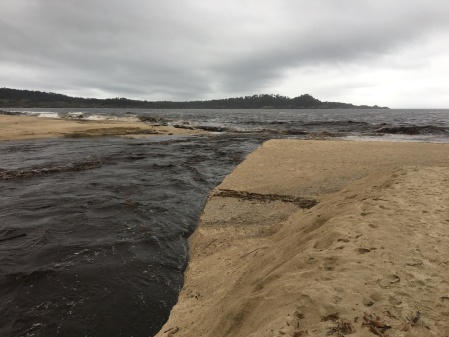
About 10 times this much water is now flowing across the sandbar at the Carmel River mouth.
The Carmel River peaked at 9.1 feet early this morning at Rosie’s Bridge in the Carmel Valley Village. That’s a flow of more than 7,000 cubic feet per second – and the largest flow the Carmel River has seen since 1998. 9 feet at Rosie’s Bridge is considered “minor flood stage” – although some flooding did occur earlier this week with the river below that level.
Runoff from lower tributaries has increased the size of the peak as it has travelled down Carmel Valley and 10,100 cfs are now passing the “Near Carmel” gauge near the river mouth. Further upstream, at Rosie’s Bridge, the river has already dropped to 7.26 feet (4,450 cfs).
Contrary to speculation on social media, the removal of the San Clemente Dam is not causing higher flows in Carmel Valley. The dam had been silted in, and having no impact on river flows, for decades before it was demolished.
What is of concern, are reports that the river has scoured away the carefully constructed “step pools” in its bypass channel at the former dam site and is incising that channel more deeply, leading to bank collapse and the loss of trees in the riparian zone upstream. It will be interesting to see what the new channel looks like, and how accommodating it will be for fish, once the water goes down.
8:30 am Update: The peak flows have now moved out to sea and all parts of the river are quickly receding. Flow at the mouth is now under 9,000 cfs.



 Posted by xasauan
Posted by xasauan 

